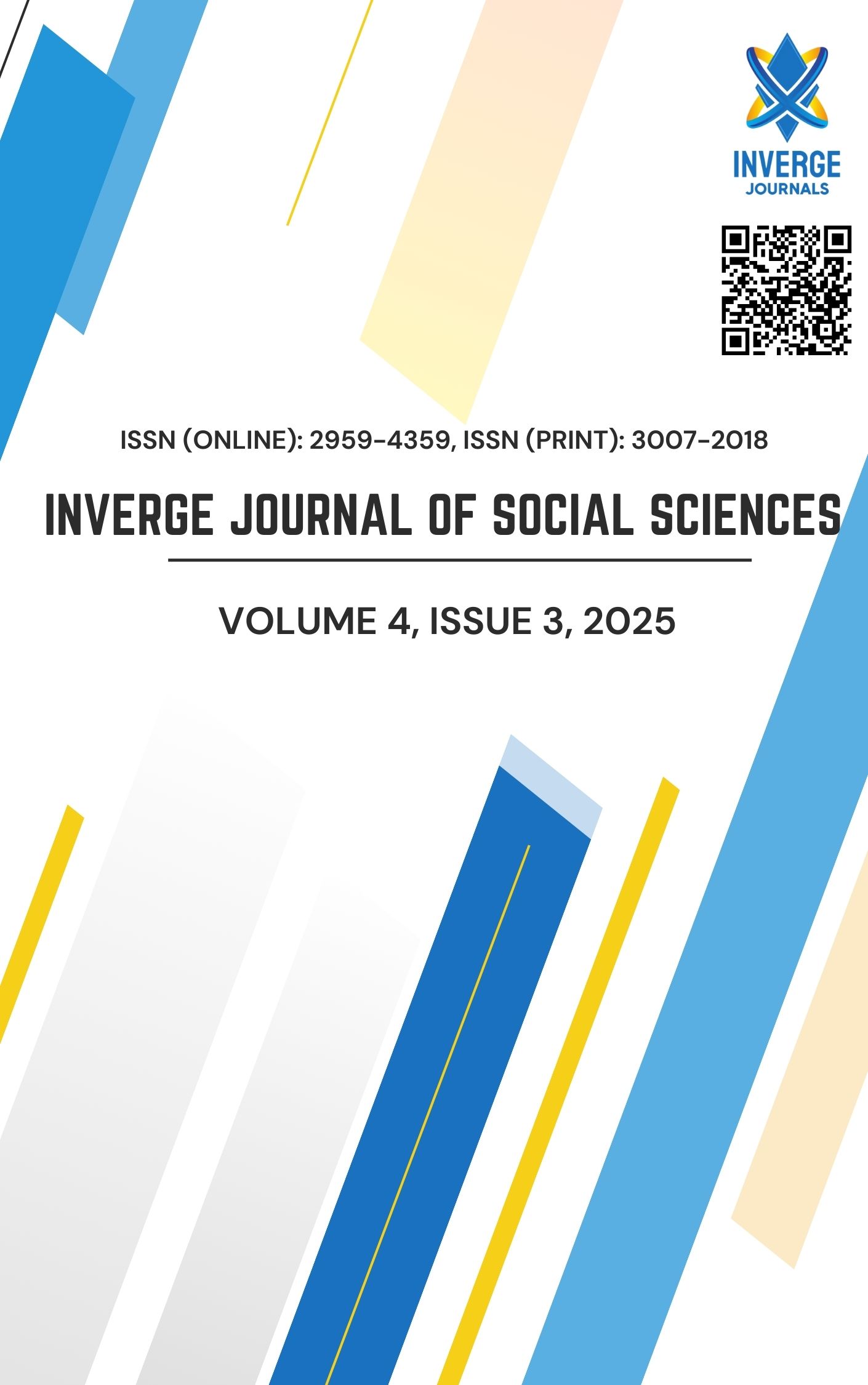Shaping Young Minds: How School Environment Predicts Social and Emotional Learning (SEL) in Primary Schools
DOI:
https://doi.org/10.63544/ijss.v4i3.154Keywords:
Social and Emotional Learning (SEL), School Environment, Primary Schools, Classroom Effort, Engagement, School Safety, Rigorous ExpectationsAbstract
The current quantitative cross-sectional study addresses how SEL can be meaningfully embedded in a resource-constrained primary school environment. The main objective of the study was to examine the predictive relationship between different dimensions of the school environment on SEL. Through proportionate stratified random sampling (25%), 302 students (males = 156, Females = 146) were selected from classes IV and V from Karachi West schools. The Panorama Social-Emotional Learning Survey for Grades 3–5 was used for data collection on-site, which covers SEL competencies and school environment aspects. The findings reveal that there is a significant positive correlation between SEL and classroom effort (r = .291), and SEL and rigorous expectations (r = .428). However, for other dimensions, the relationship was negative and weak. Additionally, non-significant correlations were found for engagement (r = .034, p = .277) and school safety (r = -.083, p = .074) with SEL. Similar findings were observed with the multiple regression analysis, as classroom effort and rigorous expectations were the significant positive predictors, engagement was not a significant predictor of SEL, school climate was not a significant predictor, and school safety showed a marginal, non-significant effect. Thus, the study's findings can provide actionable insights for multiple stakeholders, including policymakers, curriculum developers, and educators, to create an emotionally supportive and equitable educational environment that facilitates effective SEL implementation. For this to be truly effective, aspects of SEL need to be integrated into the students’ total environment, school policy, culture, and programs. This creates an inclusive environment where students develop self-awareness, empathy, and emotional regulation, enabling them to become emotionally mature and make wise decisions.
References
Ahad, A., Langove, S. A., Kakar, A., Sohail, D. U., & Rubab, D. U. E. (2025). Quality Management in Education: Enhancing Student Outcomes through Total Quality Management (TQM) and ISO 21001 Frameworks. Inverge Journal of Social Sciences, 4(2), 156–164. https://doi.org/10.63544/ijss.v4i2.149
Ahmed, I., Hamzah, A. B., & Abdullah, M. N. L. Y. B. (2020). Effect of Social and Emotional Learning Approach on Students' Social-Emotional Competence. International Journal of Instruction, 13(4), 663-676. https://doi.org/10.29333/iji.2020.13441a
Allbright, T. N., Marsh, J. A., Kennedy, K. E., Hough, H. J., & McKibben, S. (2019). Social-emotional learning practices: Insights from outlier schools. Journal of Research in Innovative Teaching & Learning, 12(1), 35-52. https://doi.org/10.1108/JRIT-02-2019-0024
Aygün, H. E., & Taşkın, Ç. Ş. (2022). The effect of social-emotional learning program on social-emotional skills, academic achievement and classroom climate. Psycho-Educational Research Reviews, 11(1), 59-76. https://doi.org/10.52963/PERR_Biruni_V11.N1.05
Balouch, G. A., Saleem, S., & Rehman, F. (2025). Open, Adapt, and Achieve Digital Doors to Learning: Exploring How E-Learning Platforms and Professional Growth Transform Learning for Students with Special Needs. THE PROGRESS: A Journal of Multidisciplinary Studies, 6(1), 109-120.
Barlas, N. S., Sidhu, J., & Li, C. (2022). Can social-emotional learning programs be adapted to schools in Pakistan? A literature review. International Journal of School & Educational Psychology, 10(1), 155-169. https://www.tandfonline.com/doi/full/10.1080/21683603.2020.1850374#abstract
Baumsteiger, R., Hoffmann, J. D., Castillo-Gualda, R., & Brackett, M. A. (2022). Enhancing school climate through social and emotional learning: effects of RULER in Mexican secondary schools. Learning Environments Research, 25(2), 465-483. https://doi.org/10.1007/s10984-021-09376-9
Berg, J., Osher, D., Moroney, D., & Yoder, N. (2023). Creating safe, supportive, and engaging schools: A comprehensive approach to SEL and school climate. American Institutes for Research.
Borowski, T. (2019). CASEL’s framework for systemic social and emotional learning. Measuring SEL: Using Data to Inspire Practice, 8(3), 1-7.
Cefai, C., & Cavioni, V. (2013). Social and emotional education in primary school: Integrating theory and research into practice. Springer Science & Business Media. https://books.google.com.pk/books?id=WTknAQAAQBAJ&printsec=frontcover&source=gbs_ge_summary_r&cad=0#v=onepage&q&f=false
Cipriano, C., Strambler, M. J., Naples, L. H., Ha, C., Kirk, M., Wood, M., ... & Durlak, J. (2023). The state of evidence for social and emotional learning: A contemporary meta‐analysis of universal school‐based SEL interventions. Child development, 94(5), 1181-1204.
Coskun, K. (2019). Evaluation of the socio-emotional learning (SEL) activities on self-regulation skills among primary school children. Evaluation, 4, 14-2019.
da Cunha, J. M., Thomas, K. J., Sukhawathanakul, P., Santo, J. B., & Leadbeater, B. (2021). Socially responsible children: A link between school climate and aggression and victimization. International Journal of Behavioral Development, 45(6), 504-512. https://doi.org/10.1177/0165025421995915
Denham, S. A., Ferrier, D. E., Howarth, G. Z., Brown, C., & Auerbach-Major, S. (2022a). Validity of the Social-Emotional Learning (SEL) construct: Evidence from the SSIS SEL scales. Early Childhood Research Quarterly, 58, 220–231. https://www.ncbi.nlm.nih.gov/pmc/articles/PMC8852736/
Durlak, J. A., Mahoney, J. L., & Weissberg, R. P. (2022). Handbook of social and emotional learning: Research and practice. Guilford Press.
Dusenbury, L., Yoder, N., Dermody, C., & Weissberg, R. (2019). An examination of frameworks for social and emotional learning (SEL) reflected in state K-12 learning standards. Measuring SEL: Using Data to Inspire Practice, 3(1), 1-29. https://measuringsel.casel.org/wp-content/uploads/2019/02/Framework-C.3.pdf
Dyson, B., Howley, D., Shen, Y., & Baek, S. (2021). Educators' Experiences of Establishing Social and Emotional Learning Pedagogies in an Elementary School with At-Risk Students. International Electronic Journal of Elementary Education, 13(5), 625-638.
Ferreira, M., Martinsone, B., & Talić, S. (2020). Promoting sustainable social emotional learning at school through relationship-centered learning environment, teaching methods and formative assessment. Journal of Teacher Education for Sustainability, 22(1), 21-36. https://doi.org/10.2478/jtes-2020-0003
Foster, J. L., Louis, L., & Winston, E. (2022). Creating conditions for social-emotional learning: An ecological framework. Theory Into Practice, 61(2), 224-235. https://doi.org/10.1080/00405841.2022.2036051
Hawkins, G. T., Chung, C. S., Hertz, M. F., & Antolin, N. (2023). The school environment and physical and social‐emotional well‐being: implications for students and school employees. Journal of School Health, 93(9), 799-812.
Hayashi, A., Liew, J., Aguilar, S. D., Nyanamba, J. M., & Zhao, Y. (2022). Embodied and social-emotional learning (SEL) in early childhood: Situating culturally relevant SEL in Asian, African, and North American contexts. Early Education and Development, 33(5), 746-763. https://doi.org/10.1080/10409289.2021.2024062
Hussain, M., & Ahmed, M. (2023). The Pedagogical Challenges and Mitigating strategies of teaching social-emotional skills at the Secondary school level. International Journal of Social Science & Entrepreneurship, 3(1), 586-604.
Kidger, J., Araya, R., Donovan, J., & Gunnell, D. (2012). The effect of the school environment on the emotional health of adolescents: a systematic review. Pediatrics, 129(5), 925-949.
Kutsyuruba, B., Klinger, D. A., & Hussain, A. (2015). Relationships among school climate, school safety, and student achievement and well‐being: a review of the literature. Review of Education, 3(2), 103-135.
LaBelle, B. (2023). Positive outcomes of a social-emotional learning program to promote student resiliency and address mental health. Contemporary School Psychology, 27(1), 1-7. https://doi.org/10.1007/s40688-022-00440-6
MacCann, C., Jiang, Y., Brown, L. E., Double, K. S., Bucich, M., & Minbashian, A. (2020). Emotional intelligence predicts academic performance: A meta-analysis. Psychological bulletin, 146(2), 150-159. https://doi.org/10.1037/bul0000219
Mahfouz, J., & Greenberg, M. T. (2021). The role of principals in shaping school climate: A study of principal leadership and SEL implementation. Educational Administration Quarterly, 57(2), 230–263. https://doi.org/10.1177/0013161X20944686
Martinsone, B., Di Sano, S., & D'elia, P. (2023). A conceptual framework for sustainable promotion of a positive school climate: Context, challenges, and solutions. Journal of Teacher Education for Sustainability, 25(1), 64-85.
Mischel, J., & Kitsantas, A. (2020). Middle school students' perceptions of school climate, bullying prevalence, and social support and coping. Social Psychology of Education, 23(1), 51-72.
Olivera, J., & Tournier, I. (2016). Successful ageing and multi-dimensional poverty: the case of Peru. Ageing & Society, 36(8), 1690-1714. https://doi.org/10.1017/S0144686X15000665
Osher, D., Kidron, Y., Brackett, M., Dymnicki, A., Jones, S., & Weissberg, R. P. (2020). Advancing the science and practice of social and emotional learning: Looking back and moving forward. Review of Research in Education, 44(1), 1–37. https://doi.org/10.3102/0091732X20967068
Pan, Y., Liang, S., Shek, D. T., Zhou, D., & Lin, X. (2023). Perceived school climate and adolescent behaviors among Chinese adolescents: Mediating effect of social‐emotional learning competencies. Psychology in the Schools, 60(9), 3435-3451. https://onlinelibrary.wiley.com/doi/full/10.1002/pits.22932
Rehman, F., & Sajjad, S. (2025). Bridging Technology and Therapy: Exploring AI in Mental Health Services through Counselors' and Students' Perspectives. Online Media and Society, 6(1), 31-44.
Rehman, F., & Sajjad, S. (2024). Unlocking Student Satisfaction: The Impact of Therapeutic Engagement in University Counseling Services. International Research Journal of Management and Social Sciences, 5(2), 311-321.
Rimm-Kaufman, S. E., Baroody, A. E., Larsen, R. A. A., & Curby, T. W. (2022). Emotional support in classrooms and its links to social-emotional outcomes. Journal of School Psychology, 90(3), 1–15.
Roztocki, N., Soja, P., & Weistroffer, H. R. (2019). The role of information and communication technologies in socioeconomic development: towards a multi-dimensional framework. Information Technology for Development, 25(2), 171-183.
Sajjad, S., Saleem, S., Rehman, M. F., & Scholar, M. P. (2019). Instructional planning and evaluation techniques used by teachers for their students with special needs. Journal of Economics and Sustainable Development, 10(1), 101.
Saleem, S., Balouch, G. A., & Rehman, F. (2025). Adapting to ability: educators' perspectives on the benefits and challenges of e-learning for students with special needs. EDUCATIONAL RESEARCH AND INNOVATION, 5(1), 39-56.
Schonert-Reichl, K. A. (2019). Advancements in the landscape of social and emotional learning and emerging topics on the horizon. Educational psychologist, 54(3), 222-232. https://doi.org/10.1080/00461520.2019.1633925
Shah, N. A., Sajjad, S., & Rehman, F. (2023). Causes and prevention of dropouts of students in higher secondary schools of quetta. Journal of Social Sciences and Media Studies, 7(1), 25-33.
Shahid, N., Asif, M., & Pasha, D. A. (2022). Effect of Internet Addiction on School Going Children. Inverge Journal of Social Sciences, 1(1), 13–55. https://doi.org/10.63544/ijss.v1i1.3
Shernoff, D. J., Ruzek, E. A., & Sinha, S. (2017). The influence of the high school classroom environment on learning as mediated by student engagement. School psychology international, 38(2), 201-218.
Sökmen, Y. (2021). The role of self-efficacy in the relationship between the learning environment and student engagement. Educational Studies, 47(1), 19-37. https://doi.org/10.1080/03055698.2019.1665986
Stodden, D. F., Pesce, C., Zarrett, N., Tomporowski, P., Ben-Soussan, T. D., Brian, A., ... & Weist, M. D. (2023). Holistic functioning from a developmental perspective: A new synthesis with a focus on a multi-tiered system support structure. Clinical Child and Family Psychology Review, 26(2), 343-361.
Taylor, R. D., Oberle, E., Durlak, J. A., & Weissberg, R. P. (2017). Promoting positive youth development through school‐based social and emotional learning interventions: A meta‐analysis of follow‐up effects. Child development, 88(4), 1156-1171. https://doi.org/10.1111/cdev.12864
Todd, C., Smothers, M., & Colson, T. (2022). Implementing SEL in the classroom: A practitioner perspective. The Clearing house: A Journal of Educational Strategies, 95(1), 18-25.
UNESCO. (2021). Promoting social and emotional learning in schools: Policy and practice across countries. United Nations Educational, Scientific and Cultural Organization.
Van Huynh, S., Giang, T. V., Nguyen, H. T., Luu-Thi, H. T., & Tran-Chi, V. L. (2023). Responsible making-decision competency based on the social emotional learning model for Vietnamese high school students. Journal of Law and Sustainable Development, 11(7), e1007-e1007. https://ojs.journalsdg.org/jlss/article/view/1007/588
Villares, E., Brigman, G., Carbonneau, K., Bowers, H., & Lemberger-Truelove, M. E. (2023). The effects of the student success skills program on academic achievement and social-emotional skills and competence: A meta-analysis. Journal of Child and Adolescent Counseling, 9(2), 192-204.
Wang, M. T., & Degol, J. L. (2016). School climate: A review of the construct, measurement, and impact on student outcomes. Educational psychology review, 28(2), 315-352. https://doi.org/10.1007/s10648-015-9319-1
Whiting, C. C., Ochsenbein, M., Schoen, S. A., & Spielmann, V. (2022). A multi-tiered and multi-dimensional approach to intervention in schools: Recommendations for children with sensory integration and processing challenges. Journal of Occupational Therapy, Schools, & Early Intervention, 15(3), 314-327.
Wigelsworth, M., Eccles, A., & Santos, J. (2021). Social and Emotional Learning: A Survey of English Primary School's Priorities, Perceptions, and Practices. International journal of emotional education, 13(2), 23-39.
Zadorozhna-Knyagnitska, L., & Hadzhinova, I. (2021). Development of primary students’ emotional intelligence: analysis of foreign experience. Comparative Professional Pedagogy, 11(2), 48-54.
Downloads
Published
How to Cite
Issue
Section
Categories
License
Copyright (c) 2025 Iffat Sultana, Prof. Dr. Shahida Sajjad

This work is licensed under a Creative Commons Attribution-NonCommercial-ShareAlike 4.0 International License.
The work is concurrently licensed under a Creative Commons Attribution-NonCommercial-ShareAlike 4.0 International License, which permits others to share the work with an acknowledgement of the authorship and the work's original publication in this journal, while the authors retain copyright and grant the journal the right of first publication.









